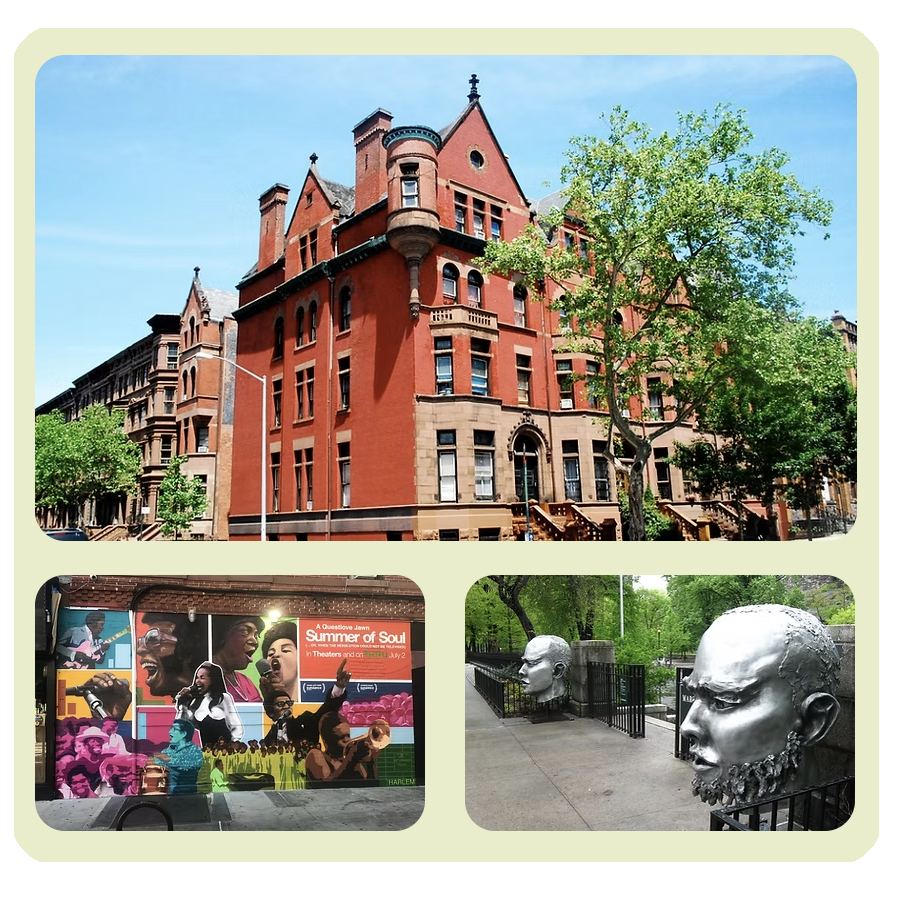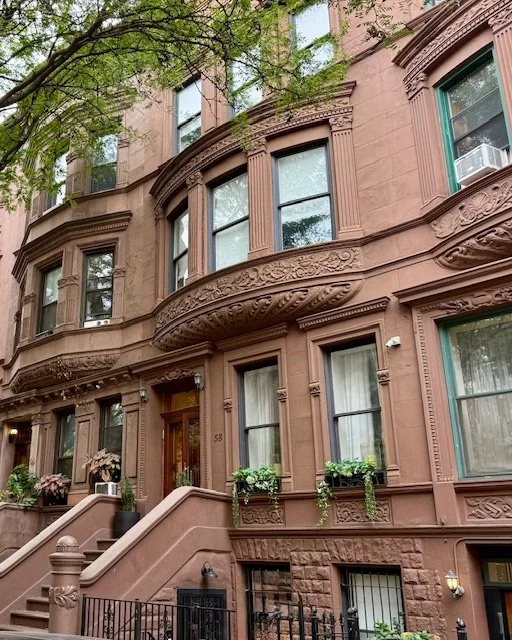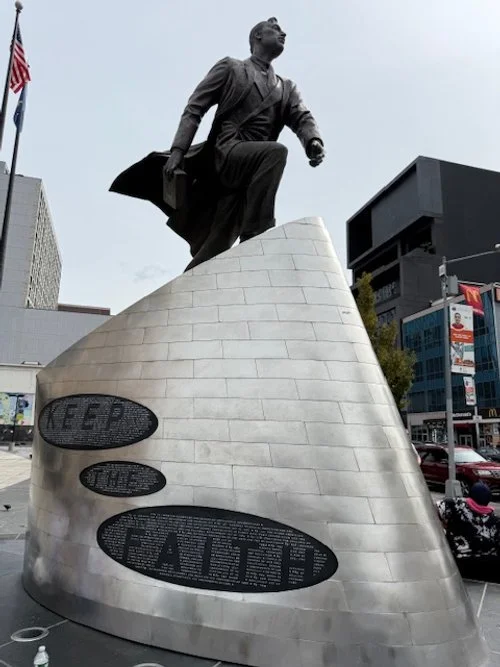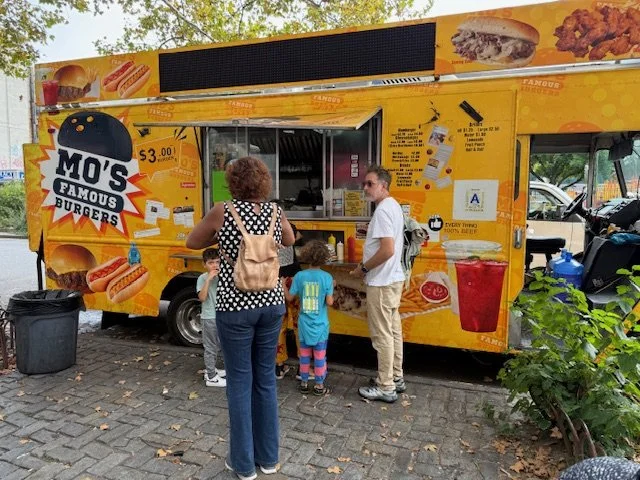Walking Harlem’s History on International Greeter Day
On International Greeter Day, a celebration held each September by Greeter programs around the world, Carolyn D. Johnson led a group of Big Apple Greeters through her beloved Harlem.
As president of Welcome to Harlem — the tour company she founded in 2004 —Johnson has spent two decades celebrating and preserving the neighborhood’s history and culture through walking tours, live jazz programs, and educational initiatives. The day is meant to honor locals who open their cities to the world —making Johnson, after 20 years of doing just that, a truly inspired choice to guide our walk.
Mapping the Tour
She began by noting that Harlem stretches 6.2 miles from the Harlem and East Rivers to the Hudson. It encompasses several distinct areas: Central Harlem, East Harlem (also known as Spanish Harlem), and Hamilton Heights (sometimes called West Harlem or Sugar Hill).
Our route focused on Central Harlem, from 116th to 125th Street, passing through the Mount Morris Park Historic District—a tranquil pocket of tree-lined streets and graceful brownstones—before reaching 125th Street, the neighborhood’s commercial artery.
Mount Olivet Baptist Church
Our first stop set a spiritual tone. Inside the historic Mount Olivet Baptist Church, at Lenox Avenue (Malcolm X Boulevard) and 120th Street, we joined the Harlem Gospel Series for an hour of uplifting music that drew the audience into clapping, singing, and swaying along.
Built in 1907 as Temple Israel, a grand Reform synagogue, the building still bears traces of its origins. Stars of David can be seen in the column capitals and fanlights — a reminder that these streets have long welcomed diverse communities. Mount Olivet Baptist Church, an African American congregation, purchased the edifice in 1925, establishing it as a pillar of Harlem life.
Malcolm X’s Enduring Legacy
From the hymns of Mount Olivet, we stepped into a different kind of spiritual space. Just a few blocks away, at 116th Street, stands Masjid Malcolm Shabazz, formerly the Nation of Islam’s Mosque No. 7. The building itself has a layered history—it began in 1905 as the Lenox Casino.
Malcolm X served here as minister until his separation from the Nation of Islam in early 1964. After his assassination the following year, the original mosque was firebombed. The site was rebuilt and renamed Masjid Malcolm Shabazz to honor El-Hajj Malik El-Shabazz, the name Malcolm adopted after his pilgrimage to Mecca.
Landmarks of Activism
That spirit of leadership extends to Marcus Garvey Park, originally called Mount Morris Park when it was created in 1840. The park was renamed in 1973 for the Jamaican activist who made Harlem a center of Black empowerment. In 1917, Garvey founded the U.S. chapter of the Universal Negro Improvement Association here, promoting racial pride and self-reliance.
More than 50 years later, that same green space hosted the Harlem Cultural Festival of 1969. Over six Sundays that summer, more than 300,000 people gathered to hear icons like Stevie Wonder, Nina Simone, BB King, and Mahalia Jackson. Footage of the event, which became known as “The Black Woodstock,” remained unseen for decades before being brought to life in Ahmir “Questlove” Thompson’s documentary Summer of Soul (2021).
That civic energy still thrives today. On West 120th Street, we met young volunteers from the Marcus Meets Malcolm initiative, which runs an Open Streets program that revitalizes the area through community service and cultural events.
Brownstone Elegance: Doctor’s Row
Graceful brownstones line Mount Morris Park West and West 122nd Street, at the heart of the Mount Morris Park Historic District. Built in the late 19th century, these stately homes were crafted from sandstone quarried in Connecticut and shipped down the Connecticut River to New York stone yards. The stone’s warm reddish-brown hue gave the architectural style its enduring name.
Once known as Doctor’s Row, this stretch was home to many of Harlem’s physicians and professionals. Standing on its tree-shaded sidewalks today, you can still sense the quiet grandeur of that era in the proud stoops and intricate carvings.
Birthplace of a Movement
Our walk next led us to Harlem’s creative heart—the blocks near Lenox Avenue and 124th Street, where the Harlem Renaissance took root. During the 1920s and ’30s, artists such as writers Langston Hughes and Zora Neale Hurston, musician Duke Ellington, and photographer James Van Der Zee transformed Harlem into the epicenter of Black American culture. As Johnson noted, their work was both an act of creativity and a declaration of resilience rooted as much in community as in art.
125th Street: History and Commerce
The final leg of our walk brought us to 125th Street, where history and commerce meet. Johnson highlighted cultural landmarks such as the Studio Museum in Harlem (founded in 1968 and original home to the James Van Der Zee archive, now stewarded by The Metropolitan Museum of Art since 2021) and the storied Hotel Theresa, once known as the “Waldorf of Harlem.” The hotel famously hosted figures from Josephine Baker and Duke Ellington to Fidel Castro.
Nearby, the former Blumstein’s Department Store marks the site of Adam Clayton Powell Jr.’s 1934 “Don’t Buy Where You Can’t Work” campaign, which successfully opened jobs to Black New Yorkers.
We concluded at the Apollo Theater, Harlem’s most celebrated stage, now under restoration and slated to reopen in 2026. Along the avenue, national retailers like Target, Trader Joe’s, and Whole Foods now share space with long-standing local businesses—a portrait of a neighborhood in motion.
Sweet Ending
No visit to Harlem is complete without sampling its great food. Icons like Sylvia’s and Red Rooster continue to draw locals and visitors alike, while newer cafés and global eateries keep the culinary scene vibrant.
Our guide also led us to some of her favorites, including Mo’s Famous Burgers and Sugar Hill Creamery, known for handmade, small-batch ice cream, and Jacob’s Soul Food Restaurant.
The tour ended as the best Greeter walks do — with new friendships and a renewed appreciation for our wonderful city. We left Harlem feeling inspired and eager to return.





